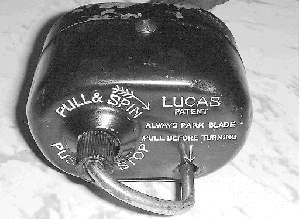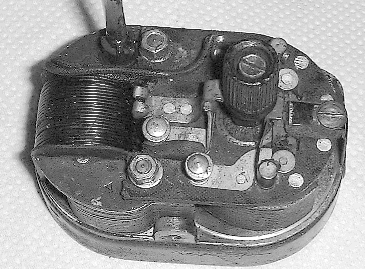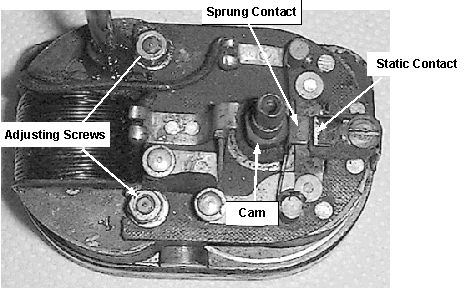Last updated: 3rd December 2024
Wiper Motor Adjustment
 After
the vacuum driven wiper motor a strange electrical device was fitted to Austin
Sevens which used a pulse motor to drive the wipers. In this type of motor there
is no continuous flow of current through the coils of the armature ( that
sausage bit in the middle that spins round, the same as in a dynamo ) but a
contact breaker ( very similar to the one in the distributor ) which puts a
pulse of current into the coils around the armature creating a short pulse of
magnetism. This rotates the armature sufficiently that the contact breaker
closes again and puts another pulse into the armature. To set all this going the
driver spins the armature by hand using the on-off knob. Once running the wiper
motor keeps spinning, or rather should do.
After
the vacuum driven wiper motor a strange electrical device was fitted to Austin
Sevens which used a pulse motor to drive the wipers. In this type of motor there
is no continuous flow of current through the coils of the armature ( that
sausage bit in the middle that spins round, the same as in a dynamo ) but a
contact breaker ( very similar to the one in the distributor ) which puts a
pulse of current into the coils around the armature creating a short pulse of
magnetism. This rotates the armature sufficiently that the contact breaker
closes again and puts another pulse into the armature. To set all this going the
driver spins the armature by hand using the on-off knob. Once running the wiper
motor keeps spinning, or rather should do.
If there is insufficient power in the pulse to keep the armature moving another quarter revolution the whole thing stops; the two normal causes are the contacts of the contact breaker are dirty or the are incorrectly adjusted.
So how do we go about keeping the wiper running smoothly?

Firstly we need to make sure that the contact breaker points are clean,
they open and close four times for every revolution of the armature,
which in turn revolves many times for each sweep of the wiper arm. Clean
them with a little slip of fine abrasive paper between the points. If
you revolve the armature so that the points are open there is enough
room for a slip of emery paper. Whilst the paper is between the points,
rotate the armature a little so that the points close a little and then
drag the paper from between the points.
Don’t be too rough, they are quite delicate. You will notice that the
contact closes to the cam on the armature is attached to a leaf spring
which in turn is attached to two posts by small screws. This can be
carefully removed if the points are in bad condition and the surface of
the points can be carefully cleaned up. It’s a bit fiddly so it is
actually better to leave all in place.

Once you have cleaned the contacts, connect the motor to a power
supply, loosen the adjusting screws and slide the whole bakelite (see
arrows on diagram above) plate so when the armature is spun it rotates
freely and at its maximum speed. Lock the two adjusting screws when you
are happy with the setting.
A little lubrication on the cam (very little) will help as will adequate
grease in the gearbox under the wiper motor which is accessed by
removing the plate underneath the motor as it appears in the picture.
This article, written by Malcolm Watts, originally appeared in CA7C Seven Focus in May 2001 pp 10-11.
See also: